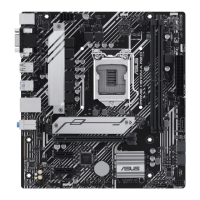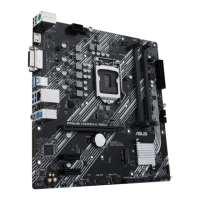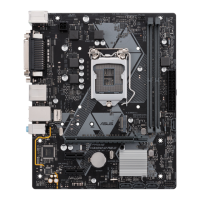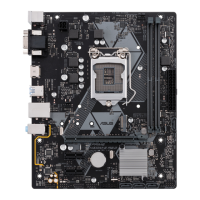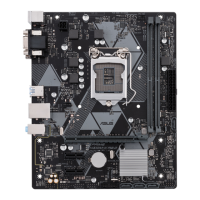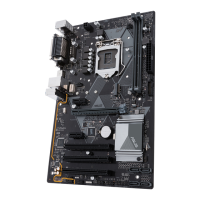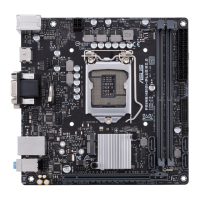
Do you have a question about the Asus PRIME H510T2-CSM R2.0 and is the answer not in the manual?
| Brand | Asus |
|---|---|
| Model | PRIME H510T2-CSM R2.0 |
| Category | Motherboard |
| Language | English |
Precautions to prevent electrical shock hazard during system operation and component handling.
Precautions for safe installation and operation of the motherboard and its components.
Warning about swallowing coin batteries and seeking immediate medical attention.
Explains the structure and contents of the user guide, detailing its main chapters.
Lists resources for additional product and software updates, including the ASUS website.
Explains symbols used in the manual to convey important information and warnings.
Details CPU socket compatibility, processor generations, and turbo boost technology support.
Identifies the Intel® H470 Chipset used on the motherboard.
Specifies memory configuration, including SO-DIMM slots, maximum capacity, and memory types.
Outlines graphics output ports, supported resolutions, and output priorities.
Lists storage interfaces, including M.2 slots and SATA ports.
Details the LAN controller and its speed, including ASUS LANGuard features.
Enumerates USB ports on the rear and front panels and their specifications.
Describes the audio codec and its playback capabilities.
Lists and describes the connectors available on the rear panel of the motherboard.
Details various internal connectors on the motherboard for system components and features.
Specifies the BIOS type and capacity.
Indicates the manageability features supported by the motherboard.
Lists the supported operating system.
Specifies the physical dimensions and form factor of the motherboard.
Outlines essential precautions to take before installing motherboard components or changing settings.
Describes the LGA1200 socket and its CPU compatibility.
Details the two SO-DIMM slots for DDR4 memory modules.
Explains the function of the fan header for system cooling.
Describes the motherboard's power connectors and their orientation.
Details the M.2 slot for installing M.2 SSDs.
Explains the SATA 6Gb/s port for connecting storage devices.
Describes the USB 3.2 Gen 1 header for additional front panel USB ports.
Explains the USB 2.0 headers for additional USB 2.0 ports.
Describes the header used to clear the CMOS settings.
Explains the system panel header for power LEDs, buttons, and reset.
Explains the DC power connector and adapter requirements.
Describes the HDMI ports for high-definition multimedia output.
Identifies the VGA port for connecting monitors.
Details the USB 3.2 Gen 1 ports for connecting external devices.
Explains the Ethernet port for network connectivity and its LED indications.
Describes the high-speed USB 3.2 Gen 2 ports.
Step-by-step guide on how to properly install the CPU into its socket.
Step-by-step instructions for installing a memory module into the DIMM slot.
Step-by-step instructions for removing a memory module from the DIMM slot.
Explains the features and benefits of the ASUS Self-Recovering BIOS.
Guides users on how to enter and use the BIOS setup utility.
Instructions on how to access BIOS during the initial system startup (POST).
Methods to enter BIOS after the system has already passed POST.
Provides an overview of the BIOS interface, including menu bar and general help.
Instructions on how to load optimal default values for BIOS settings.
Explains how to save modified BIOS settings and restart the system.
Guides on how to exit BIOS without saving any changes.
Details FCC compliance rules and user guidance for interference.
States compliance with Canadian ISED regulations.
Provides Japan VCCI compliance information for Class B ITE devices.
Outlines ASUS's commitment to environmental regulations and compliance disclosures.
Provides information on ASUS's voluntary manufacturer's commercial guarantee.
Lists contact addresses for ASUS headquarters and international branches.
Directs users to the ASUS multi-language website for support.
